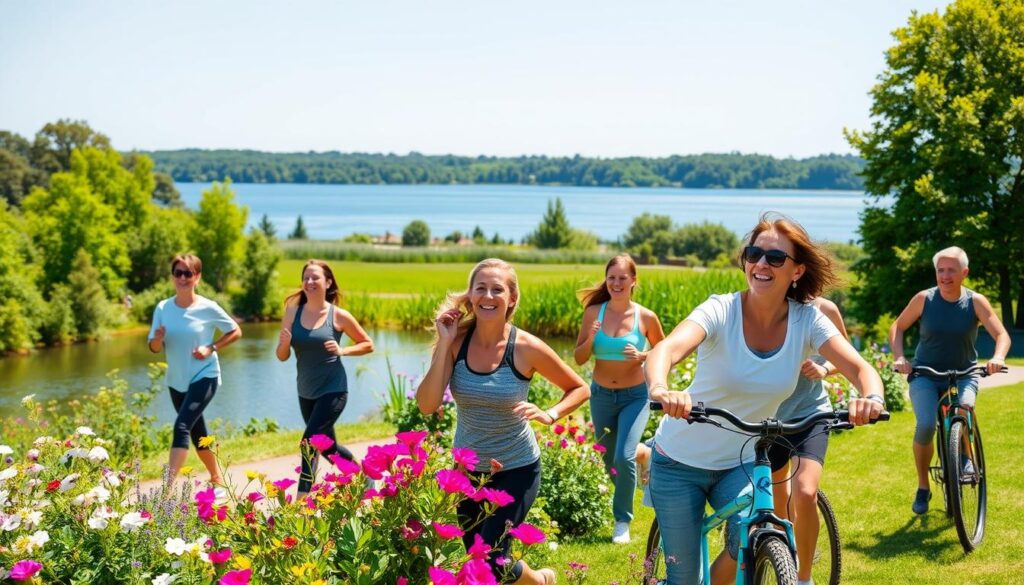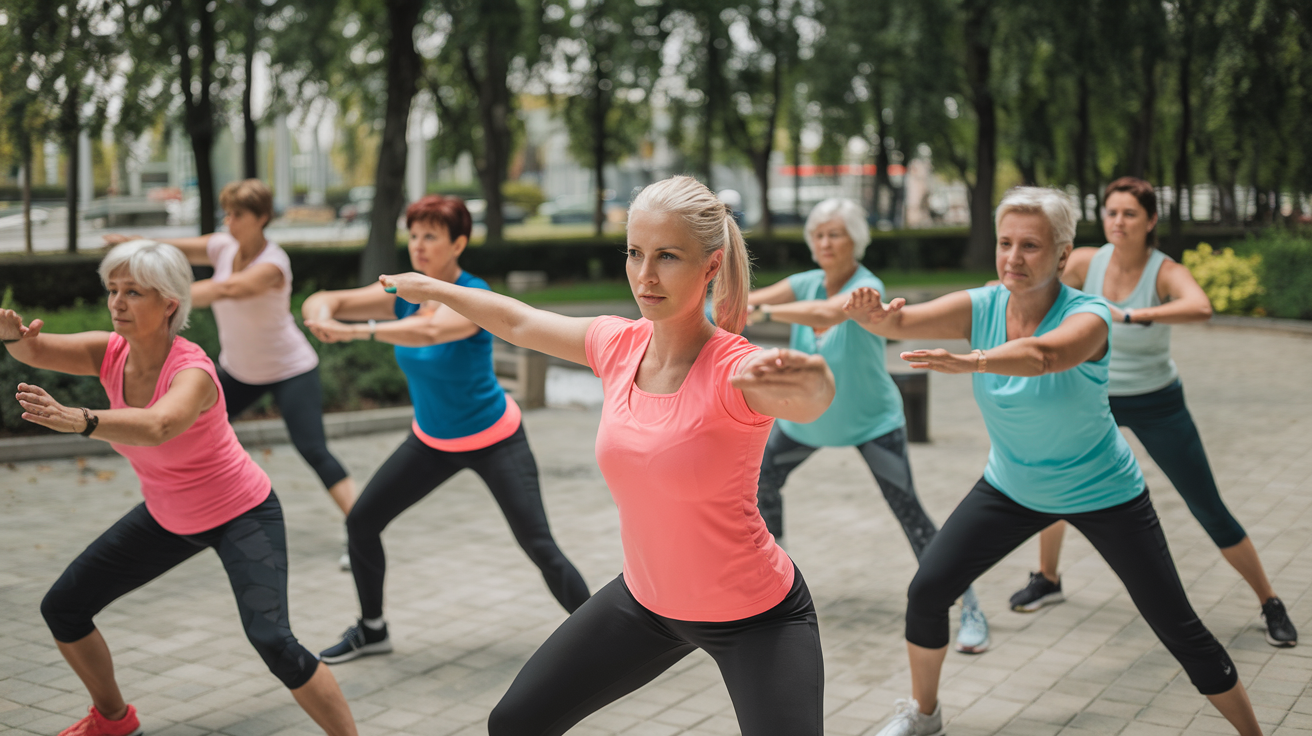Did you know that certain exercises can greatly improve your bone health and prevent osteoporosis? For women aged 18 to 65, these exercises are key. They help prevent osteoporosis and boost your overall health by strengthening bones and muscles. Let’s explore how to naturally strengthen your bones from young adulthood to post-menopause.
Key Takeaways
- Regular exercise is vital for preventing osteoporosis and improving women’s health.
- Studies show that even daily 12-minute yoga sessions for 10 years improve bone density, mainly in older adults with osteoporosis or osteopenia1.
- Nurses who walked for four hours a week reduced their risk of hip fractures by 41% compared to those who walked less than an hour a week1.
- The Bone Health & Osteoporosis Foundation reports that 10 million Americans have osteoporosis and 44 million are at risk due to low bone density2.
- Engaging in weight-bearing and resistance exercises can reduce the risk of falls by 26%2.
Importance of Exercise for Women’s Bone Health

Staying active is key for women’s bone health. Activities like weight-bearing and resistance training help build bone and slow down loss. This natural bone density enhancement is vital for strong bones.
How Exercises Improve Bone Density
Doing osteoporosis prevention exercises like weight-bearing and resistance training boosts bone density. These activities make bones stronger by adding more cells. Studies show that strength training helps postmenopausal women’s bones get stronger3.
Women can lose up to 20% of their bone mass after menopause. So, regular exercise is even more important4.
Key Benefits of Exercise in Preventing Osteoporosis
Regular osteoporosis prevention exercises are vital in reducing fracture risk. In 2011, over 1.7 million people were hospitalized for fragility fractures. The cost of osteoporosis treatment was over 70 billion dollars in the U.S3..
By adding exercises to their daily routine, women can lower their fracture risk. This is critical after menopause when bone mass drops sharply3.
Role of Exercise in Enhancing Balance and Coordination
Exercises like yoga and Tai Chi are also important for balance exercises for women. They improve balance and coordination, reducing the risk of falls. Falls are a major cause of hip fractures5.
Over 95% of hip fractures are due to falls5. Older women, who are more prone to falls, greatly benefit from these activities. They enhance stability and prevent serious injuries.
- Regular exercise boosts bone mass during adolescence, impacting long-term bone health3.
- Women over the age of 65 should do balance exercises for women at least 2 days a week4.
- Bone health exercises should combine both weight-bearing impact exercises and non-weight-bearing activities5.
| Age Group | Recommended Exercise | Benefits |
|---|---|---|
| Children and Teens | 60 mins/day of moderate-intensity physical activity | Builds bone strength and density4 |
| Adults Under 65 | 150 mins/week of moderate-intensity physical activity | Enhances bone density and overall health4 |
| Adults Over 65 | Same as under 65 + balance exercises 2 days/week | Prevents falls and maintains bone strength4 |
Weight-Bearing Exercises for Strong Bones

Doing weight-bearing exercises is key to keeping bones strong and preventing them from getting weaker with age. Let’s look at some important activities that can greatly improve your bone health.
Walking and Jogging
Walking and jogging are great for your bones because they make them work harder. By doing jogging for bone health regularly, your bones get stronger. This is because they are in contact with the ground, which helps prevent them from getting weaker.
Over half of adults over 50 are at risk of bone fractures. This is because of osteoporosis or low bone density. So, it’s very important to do these exercises. Bone loss speeds up after menopause, making these exercises even more vital6.
Dancing
Dancing is a fun way to exercise and strengthen your bones. It’s not just good for your bones; it also improves your heart health, muscle strength, balance, and coordination. This reduces the chance of falling7.
High-impact dancing is best for younger women to build bone mass. For those at higher risk of fractures, low-impact dancing is better8.
Stair Climbing
Stair climbing is a great exercise for your bones, focusing on the hips, spine, and legs. Even a little stair climbing can help your bone health, which starts to decline after 30. It also helps keep muscle mass6.
Adding stair climbing to your weekly routine can really help. It’s in line with the advice to do weight-bearing exercises at least three times a week for strong bones8.
Here’s a summary of the benefits of these exercises:
| Exercise | Benefits |
|---|---|
| Walking and Jogging | Increases bone density, improves cardiovascular health, easy to start. |
| Dancing | Strengthens bones, improves balance and coordination, fun and engaging. |
| Stair Climbing | Targets hips, spine, and legs, strengthens bones, easily incorporated into daily routine. |
Strength Training for Bone Health
Strength training is key for bone health, more so for women. You can use free weights, weight machines, or resistance bands. These exercises help strengthen muscles and bones. Let’s explore how to use resistance training to build stronger bones.
Free Weights and Weight Machines
Free weights and weight machines are great for growing bones and keeping them strong. They help create new bone and prevent bone loss, which is good for those over 50. They lose about 1% of bone mass each year9.
Free weight exercises are perfect for women, as they boost bone density at stressed areas10. It’s important to keep the right form and move slowly to avoid injuries, if you have thin bones.
Resistance Bands
Resistance bands are a low-impact, yet effective way to strengthen muscles and bones. They create tension that helps bones become stronger. This training targets high-risk areas like hips, wrists, and knees, improving bone health9.
People with Gaucher disease, for example, often face bone deterioration. Using resistance bands can help manage and improve bone density11.
Body Weight Exercises
Body weight exercises like squats, lunges, and push-ups are great for building bone density. They use your body’s weight against gravity, making them ideal for women10. Doing these exercises can also improve your core and balance, helping prevent falls and fractures11.
Adding body weight exercises to your routine twice a week can boost bone strength and overall health.
Exercises for Women’s Bone Health
Keeping your bones healthy is key, and it’s more important for women. You’re at higher risk for osteoporosis and osteopenia. About 54 million Americans have these conditions12. Let’s explore some *comprehensive bone health exercises* that can help a lot.
It’s best to mix different types of exercises. You should do strength training, balance exercises, and weight-bearing workouts. This mix helps increase bone density and boosts health. Strength training can include free weights, resistance bands, and body weight exercises13.
Increasing the weight you lift is also key. You should add 2-10% more weight for upper body exercises and 5-10% for lower body exercises every four weeks. This helps strengthen bones and lowers the risk of osteoporosis12.
Weight-bearing exercises are great for building strong bones. Walking, jogging, dancing, and climbing stairs are good choices. The Department of Health and Human Services suggests at least 150 minutes of moderate-intensity or 75 minutes of high-intensity exercise weekly for adults13. These exercises are good for both your bones and heart.
When doing *safe exercises for osteoporosis*, avoid high-impact activities. These include hiking, jumping rope, and running, which can be too hard on bones. Instead, choose lower-impact exercises like swimming or biking. They help strengthen muscles but might not directly help bones13. Also, be careful with exercises that involve bending forward or rotating the trunk, like sit-ups or golf13.
| Exercise Type | Example Exercises | Benefits |
|---|---|---|
| Weight-Bearing | Walking, Jogging, Dancing | Builds strong bones, improves cardiovascular health |
| Strength Training | Free Weights, Resistance Bands, Body Weight Exercises | Increases bone density through progressive overload |
| Balance Exercises | Single-leg stands, Tai Chi | Enhances stability and reduces fall risk |
I want to help you with these *comprehensive bone health exercises*. They not only strengthen bones but also improve overall health. By focusing on *safe exercises for osteoporosis* and mixing weight-bearing, strength, and balance activities, you can create a routine that meets your needs.
Balance Training to Prevent Falls
Balance training is key for staying stable and preventing falls. It’s very important for older women, who are more likely to get osteoporosis. We’ll look at three great balance exercises: Tai Chi, walking on uneven surfaces, and step-ups and lunges.
Tai Chi
Tai Chi is a gentle exercise that focuses on slow movements and deep breathing. It’s great for improving balance and coordination, which helps avoid falls. Tai Chi also makes muscles stronger and improves balance, reducing the risk of broken bones and falls in older adults14.
A study with elderly women with osteoporosis found Tai Chi greatly improved balance scores. It also lowered the number of falls per patient15.
Walking on Uneven Surfaces
Walking on uneven surfaces, like trails or grass, is a top-notch balance exercise. It challenges your sense of balance and improves posture and mobility. This is very important for those with osteoporosis.
Falls cause 90% of hip fractures in the elderly. So, it’s vital to add balance exercises to your daily routine15.
Step-Ups and Lunges
Step-ups and lunges are simple yet effective balance exercises. They strengthen the legs, hips, and core. These exercises boost balance, flexibility, and stability.
Doing them often can prevent falls and reduce bone fracture risks. Regular exercise like this increases muscle strength, balance, and lowers bone breakage chances14.
Combining Different Types of Exercises
Mixing different exercises is key for strong bones. Doing a variety of workouts helps a lot. Strength training, balance exercises, and aerobic activities boost bone density and health.
For example, brisk walking (3 to 4 miles per hour) is great for bones16. Adults should do at least 150 minutes of moderate exercise weekly for bone health16. Walking, jogging, and stair climbing are good choices17.
Doing muscle-strengthening activities two to three times a week is beneficial17. Each session should last 20 to 30 minutes. Progressive muscle resistance training, where you increase the weight lifted, is also recommended17.
Older adults need balance training, aerobic exercises, and muscle-strengthening activities for healthy bones and to prevent falls16. Pregnant women and new moms should do at least 150 minutes of moderate exercise weekly for bone health16.
Children and teens aged 6 to 17 should exercise for at least an hour daily16. They should do muscle-strengthening and bone-strengthening activities three days a week16. This way, everyone can keep their bones healthy with varied workouts.
Safe Exercise Practices for Women with Osteoporosis
Exercising right is key for women with osteoporosis to keep bones strong and avoid fractures. I’ll show you how to stay active safely and effectively.
Low-Impact Exercises
Low-impact workouts are best for osteoporosis. Walking, elliptical training, and low-impact aerobics are great. These exercises build bone density without harming your joints and bones18. Doing weight-bearing exercises for 30 minutes daily is very helpful19.
Strength training 2 to 3 times a week is also good. Using resistance bands or light weights can strengthen bones and improve balance18. Try mixing 3 to 10 types of exercises for major muscle groups18. Don’t forget to include exercises that help prevent falls19.
Exercises to Avoid
Knowing which exercises to avoid is just as important. High-impact activities like jogging and jumping rope are risky for those with severe osteoporosis19. They can lead to strains or fractures, mainly in the spine. Also, avoid bending or twisting at the waist, like in some yoga poses or traditional sit-ups19. These can increase fracture risk and should be avoided for safety.
By choosing safe exercises and avoiding risky ones, you can stay active, improve bone health, and prevent fractures. Stay active, stay safe, and work towards stronger bones for a healthy life! 🌟
Additional Tips for Enhancing Bone Health
Keeping bones healthy is more than just working out. Eating foods rich in calcium and vitamin D is key. Adults need 1,000 mg of calcium daily, and this goes up for older folks20. Vitamin D needs are 600 IUs for those 19 to 70, and 800 IUs for those over 7020. Adding these nutrients to your meals is vital for bone health.
Changing your lifestyle can also help a lot. Stopping smoking and drinking less alcohol are big steps. Being active helps prevent osteoporosis more than being sedentary20. It’s also good to do exercises that make your bones and muscles stronger, aiming for each major muscle group twice a week21.
Getting regular bone density tests is important. This is because bone loss in women spikes at menopause20. Knowing your bone density helps tailor your diet and exercise to your needs. This ensures your nutrition and lifestyle support your bone health well.
Also, keeping a healthy weight is good for preventing falls and fractures21. Long-term use of certain drugs, like corticosteroids, can raise osteoporosis risk. So, always talk to your doctor about your meds20.
Adding these habits to your daily life can greatly improve your bone strength and overall health. A balanced approach that includes diet, exercise, and lifestyle changes is best for bone health.
Conclusion
Exercise is vital for women’s bone health. It’s a key part of staying healthy for life. By doing different exercises, you can make your bones stronger. This helps prevent osteoporosis and boosts your overall health.
A mix of weight-bearing, strength training, and balance exercises is best. Activities like walking, dancing, and climbing stairs are great. They help strengthen bones in areas that break easily. Adding resistance training with weights or bands targets these areas even more.
High-impact exercises are super effective for women after menopause. They improve bone density in the spine and hips222324.
Balance exercises, like Tai Chi and step-ups, help prevent falls. This is important for women at risk of osteoporosis. Mixing different exercises gives you the most benefits, from stronger bones to better coordination.
For women with osteoporosis, low-impact exercises are safe and helpful. They keep bones healthy without making the condition worse222324.
In our final thoughts, remember to be consistent. Regular exercise improves bone density and quality of life. Start these healthy habits today for a better future.
Source Links
- 8 Weight-Bearing Workouts for Stronger Bones
- 9 Exercises for Osteoporosis to Improve Bone Health
- Exercise Early and Often: Effects of Physical Activity and Exercise on Women’s Bone Health – PubMed
- Osteoporosis: Exercise for bone health
- Exercise for Bone Health: A Call to Action – Society for Women’s Health Research
- Weight-Bearing Exercises for Seniors: Tips from Physical Therapists
- How Exercise Can Help You Build Better Bones
- Weight Bearing Exercises for Osteoporosis to Avoid Prolapse Worsening
- How To Build Stronger Bones With Strength Training
- How to increase bone density naturally: 11 methods
- How to Build Bone Density | National Gaucher Foundation
- Exercises Every Woman Should Do To Support Bone Health, Per Doctors
- Living with Osteoporosis: 8 Exercises to Strengthen Your Bones
- Exercising with osteoporosis: Stay active the safe way
- Balance training program is highly effective in improving functional status and reducing the risk of falls in elderly women with osteoporosis: a randomized controlled trial
- Exercise for Your Bone Health
- Exercise for bone health
- Position Statement: Exercise Guidelines for Osteoporosis Management and Fall Prevention in Osteoporosis Patients
- Best Osteoporosis Exercises: Weight-Bearing, Flexibility, and More
- How to keep your bones healthy
- Exercise and Bone Health – OrthoInfo – AAOS
- The Role of High-intensity and High-impact Exercises in Improving Bone Health in Postmenopausal Women: A Systematic Review
- The Effectiveness of Physical Exercise on Bone Density in Osteoporotic Patients
- The Role of Strength Training in Preventing Osteoporosis: Functional Exercises and Evidence-Based Benefits












No responses yet